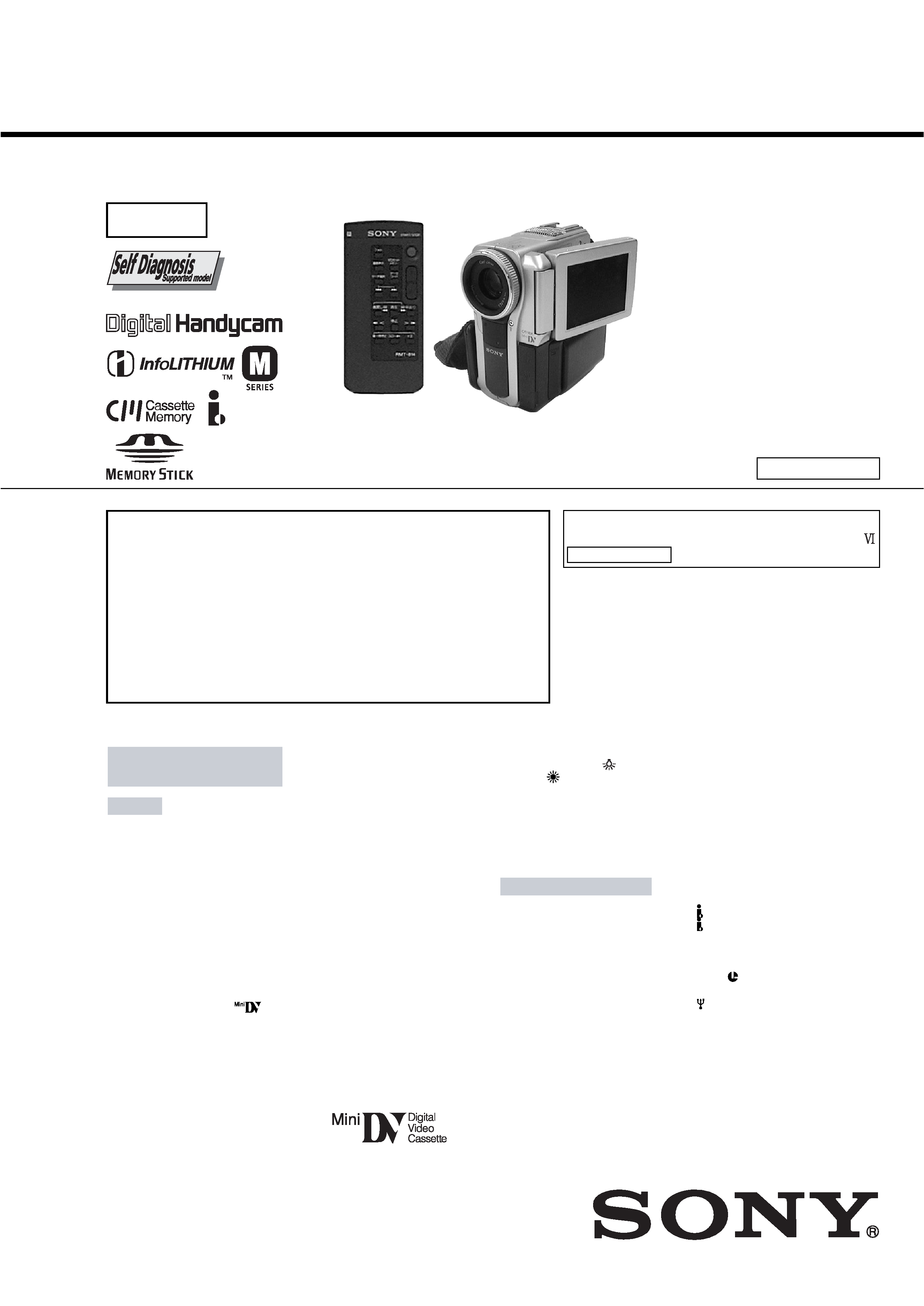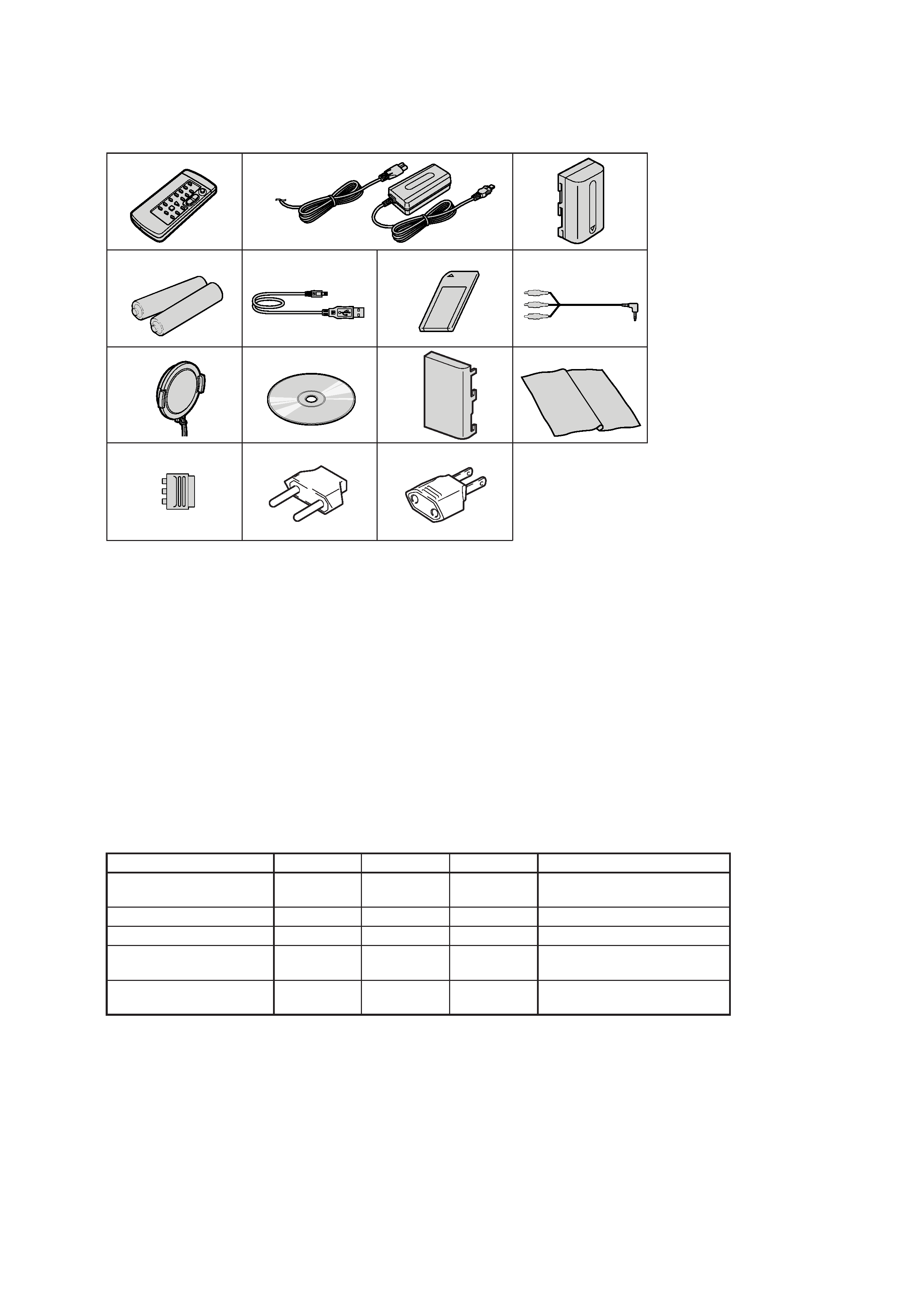
SERVICE MANUAL
SERVICE MANUAL
DIGITAL VIDEO CAMERA RECORDER
SPECIFICATIONS
For MECHANISM ADJUSTMENTS, refer to the
"DV MECHANICAL ADJUSTMENT MANUAL
J MECHANISM " (9-929-807-11).
-- Continued on next page --
Level 2
On the VC-265/265A board
This service manual provides the information that is premised the
circuit board replacement service and not intended repair inside the
VC-265/265A board.
Therefore, schematic diagram, printed wiring board, waveforms, parts
location and electrical parts list of the VC-265/265A board are not shown.
The following pages are not shown.
Printed wiring board ......................... Pages 4-15 to 4-18
Schematic diagram .......................... Pages 4-19 to 4-54
Waveforms and parts location ......... Pages 4-74 to 4-77
Electrical parts list ............................ Pages 6-13 to 6-24
DCR-PC6E/PC9/PC9E
RMT-814
Photo : DCR-PC9E
RMT-814
US Model
Canadian Model
Korea Model
DCR-PC9
AEP Model
UK Model
DCR-PC6E/PC9E
E Model
Hong Kong Model
Tourist Model
DCR-PC9/PC9E
Australian Model
Chinese Model
DCR-PC9E
J MECHANISM
NTSC model
: DCR-PC9
PAL model
: DCR-PC6E/PC9E
Video camera
recorder
System
Video recording system
2 rotary heads
Helical scanning system
Audio recording system
Rotary heads, PCM system
Quantization: 12 bits (Fs 32 kHz,
stereo 1, stereo 2), 16 bits
(Fs 48 kHz, stereo)
Video signal
PAL colour, CCIR standards
NTSC color, EIA standards
DCR-PC9:
DCR-PC6E/PC9E:
Usable cassette
Mini DV cassette with the
mark printed
Tape speed
SP: Approx. 18.81 mm/s
LP: Approx. 12.56 mm/s
Recording/playback time
(using cassette DVM60)
SP: 1 hour
LP: 1.5 hours
Fastforward/rewind time
(using cassette DVM60)
Approx. 2 min. and 30 seconds
Viewfinder
Electric viewfinder (colour)
Total dot number:
DCR-PC9/PC9E: 180 000 (800
× 225)
DCR-PC6E: 113 578 (521
× 218)
Image device
4.5 mm (1/4 type) CCD
(Charge Coupled Device)
Approx. 800 000 pixels
DCR-PC9:
DCR-PC6E/PC9E:
(Effective: 400 000 pixels)
Approx. 680 000 pixels
(Effective: 340 000 pixels)
Lens
Carl Zeiss
Combined power zoom lens
Filter diameter 30 mm. (1 3/16 in.)
10
× (Optical), 120× (Digital)
Focal length
3.3 - 33 mm (5/32 - 1 5/16 in.)
When converted to a 35 mm still
camera 42 - 420 mm (1 11/16 - 16 5/
8 in.)
Colour temperature
Auto, HOLD (Hold),
Indoor
(3 200K),
Outdoor (5 800K)
Minimum illumination
5 lx (lux) (F 1.7)
0 lx (lux) (in the NightShot mode)*
* Objects unable to be seen due to
the dark can be shot with infrared
lighting.
Input/Output connectors
S video input/output (DCR-PC9/
S video output (DCR-PC6E)
4-pin mini DIN
Luminance signal: 1 Vp-p,
75
(ohms), unbalanced, sync
negative
Chrominance signal:
75
(ohms), unbalanced
Audio/Video input/output (DCR-
PC9/PC9E)
Audio/video output (DCR-PC6E)
AV MINI JACK, input/output auto
switch
Video signal: 1 Vp-p, 75
(ohms),
unbalanced, sync negative
Audio signal: 327 mV, (at output
impedance more than 47 k
(kilohms) )
Input impedance with more than
47 k
(kilohms)
Output impedance with less than
2.2 k
(kilohms)
DV input/output (DCR-PC9/PC9E)
DV output (DCR-PC6E)
4-pin connector
Headphone jack
Stereo minijack (ø 3.5 mm)
LANC
jack
Stereo mini-minijack (ø 2.5 mm)
USB jack (DCR-PC9/PC9E only)
mini-B
PC9E)
DCR-PC6E/PC9E: 0.3 Vp-p
DCR-PC9: 0.286 Vp-p,
Ver 1.2 2005. 09

-- 2 --
SAFETY-RELATED COMPONENT WARNING!!
COMPONENTS IDENTIFIED BY MARK 0 OR DOTTED LINE WITH
MARK 0 ON THE SCHEMATIC DIAGRAMS AND IN THE PARTS
LIST ARE CRITICAL TO SAFE OPERATION. REPLACE THESE
COMPONENTS WITH SONY PARTS WHOSE PART NUMBERS
APPEAR AS SHOWN IN THIS MANUAL OR IN SUPPLEMENTS
PUBLISHED BY SONY.
ATTENTION AU COMPOSANT AYANT RAPPORT
À LA SÉCURITÉ!
LES COMPOSANTS IDENTIFÉS PAR UNE MARQUE 0 SUR LES
DIAGRAMMES SCHÉMATIQUES ET LA LISTE DES PIÈCES SONT
CRITIQUES POUR LA SÉCURITÉ DE FONCTIONNEMENT. NE
REMPLACER CES COMPOSANTS QUE PAR DES PIÈSES SONY
DONT LES NUMÉROS SONT DONNÉS DANS CE MANUEL OU
DANS LES SUPPÉMENTS PUBLIÉS PAR SONY.
1.
Check the area of your repair for unsoldered or poorly-soldered
connections. Check the entire board surface for solder splashes
and bridges.
2.
Check the interboard wiring to ensure that no wires are
"pinched" or contact high-wattage resistors.
3.
Look for unauthorized replacement parts, particularly
transistors, that were installed during a previous repair. Point
them out to the customer and recommend their replacement.
4.
Look for parts which, through functioning, show obvious signs
of deterioration. Point them out to the customer and
recommend their replacement.
5.
Check the B+ voltage to see it is at the values specified.
6.
Flexible Circuit Board Repairing
· Keep the temperature of the soldering iron around 270°C
during repairing.
· Do not touch the soldering iron on the same conductor of the
circuit board (within 3 times).
· Be careful not to apply force on the conductor when soldering
or unsoldering.
SAFETY CHECK-OUT
After correcting the original service problem, perform the following
safety checks before releasing the set to the customer.
Battery pack
NP-FM30
Maximum output voltage
DC 8.4 V
Output voltage
DC 7.2 V
Capacity
5.0 Wh (700 mAh)
Operating temperature
0
°C to 40°C (32°F to 104°F)
Dimensions (approx.)
38.2
× 20.5 × 55.6 mm
(1 9/16
× 13/16 × 2 1/4 in.)
(w/h/d)
Mass (approx.)
65 g (2.3 oz)
Type
Lithium ion
"Memory Stick"
(DCR-PC9/PC9E only)
Memory
Flash memory
4MB: MSA-4A
Operating voltage
2.7-3.6V
Power consumption
Approx. 45mA in the operating
mode
Approx. 130
µA in the standby
mode
Dimensions (approx.)
50
× 2.8 × 21.5 mm
(2
× 1/8 × 7/8 in.) (w/h/d)
Mass (approx.)
4 g (0.14 oz)
Design and specifications are
subject to change without notice.
MIC jack
Minijack, 0.388 mV low impedance
with 2.5 to 3.0 V DC, output
impedance 6.8 k
(kilohms)
(ø 3.5 mm)
Stereo type
LCD screen
Picture
6.2 cm (2.5 type)
50
× 37 mm (2 × 1 1/2 in.)
Total dot number:
DCR-PC9/PC9E: 211 200 (960
× 220)
DCR-PC6E: 123 200 (560
× 220)
General
Power requirements
7.2 V (battery pack)
8.4 V (AC power adaptor)
Average power consumption
(when using the battery pack)
During camera recording using
DCR-PC9/PC9E:
LCD: 3.5 W
Viewfinder: 2.7 W
DCR-PC6E:
LCD: 3.2 W
Viewfinder: 2.5 W
Operating temperature
0
°C to 40 °C (32 °F to 104 °F)
Storage temperature
20
°C to +60 °C (4 °F to +140 °F)
Dimensions (approx.)
58
× 104 × 97 mm
(2 3/8
× 4 1/8 × 3 7/8 in.) (w/h/d)
Mass (approx.)
490 g (1 lb 1 oz)
excluding the battery pack and
cassette
580 g (1 lb 2 oz)
including the battery pack,
NP-FM30, cassette DVM60 and lens
cap
Supplied accessories
See page 3.
AC power adaptor
AC-L10
Power requirements
100 - 240 V AC, 50/60 Hz
Power consumption
23 W
Output voltage
DC OUT: 8.4 V, 1.5 A in the
operating mode
Battery charge terminal:
4.2 V, 1.5 A in charge mode
Operating temperature
0
°C to 40 °C (32 °F to 104 °F)
Storage temperature
20
°C to +60 °C (4 °F to +140 °F)
Dimensions (approx.)
125
× 39 × 62 mm (5 × 1 9/16 × 2 1/2
in.) (w/h/d) excluding projecting
parts
Mass (approx.)
280 g (9.8 oz)
excluding mains lead

-- 3 --
· SUPPLIED ACCESSORIES
Make sure that the following accessories are supplied with your camcorder.
7
1
Wireless Remote Commander (1)
2
AC-L10A/L10B/L10C AC power adaptor
(1), Mains lead (1)
3
NP-FM30 battery pack (1)
4
R6 (size AA) battery for Remote
Commander (2)
5
USB cable (1)
DCR-PC9/PC9E only
6
"Memory Stick" (1)
DCR-PC9/PC9E only
7
A/V connecting cable (1)
8
Lens cap (1)
9
CD-ROM (SPVD-004 USB Driver) (1)
DCR-PC9/PC9E only
q;
Battery terminal cover (1)
qa
Cleaning cloth (1)
qs
21-pin adaptor (1)
European models only
qd
2-pin adaptor (1)
DCR-PC9: JE/PC9E: JE only
qf
2-pin adaptor (1)
DCR-PC9: E,HK/PC9E: E,HK only
1
5
3
4
6
89
q;
qa
2
qs
qf
qd
· Abbreviation
HK
: Hong Kong model
AUS : Australian model
CN
: Chinese model
JE
: Tourist model
DCR-PC6E
AEP,UK
DCR-PC9
US,CND,E,
HK,KR,JE
a
a
a
a
DCR-PC9E
AEP,UK,E,HK,
AUS,CN,JE
a
a
a
a
Table for difference of functions
Model
Destination
Memory stick
VCR Rec mode
DV IN/OUT
DIGITAL IN/OUT (USB)
Remark
a: with FP-347 flexible
a: with REC button
a: with IN/OUT
: with OUT
a: with IN/OUT
: with OUT

-- 4 --
TABLE OF CONTENTS
SERVICE NOTE
1.
POWER SUPPLY DURING REPAIRS ····························· 7
2.
TO TAKE OUT A CASSETTE WHEN NOT EJECT
(FORCE EJECT) ································································ 7
3.
PERCAUTION DURING INSTALLATION OF DC IN
CONNECTOR AND BATTERY TEMINAL BOARD ······ 7
SELF-DIAGNOSIS FUNCTION
1.
SELF-DIAGNOSIS FUNCTION ······································· 8
2.
SELF-DIAGNOSIS DISPLAY ·········································· 8
3.
SERVICE MODE DISPLAY ············································· 8
3-1.
Display Method ·································································· 8
3-2.
Backup No. ········································································· 8
3-3.
End of Display ···································································· 8
4.
SELF-DIAGNOSIS CODE TABLE ··································· 9
1.
GENERAL
Main Features ············································································ 1-1
Quick Start Guide ······································································ 1-1
Getting started
Using this manual ·································································· 1-2
Checking supplied accessories ·············································· 1-2
Step 1 Preparing the power supply ········································ 1-3
Installing the battery pack ··················································· 1-3
Charging the battery pack ··················································· 1-3
Connecting to a wall socket ················································ 1-4
Step 2 Setting the date and time ············································ 1-4
Step 3 Inserting a cassette ······················································ 1-5
Step 4 Using the touch panel ················································· 1-5
Recording Basics
Recording a picture ································································ 1-6
Shooting backlit subjects BACK LIGHT ························ 1-8
Shooting in the dark NightShot/Super NightShot ··········· 1-8
Self-timer recording ···························································· 1-9
Checking the recording END SEARCH/
EDITSEARCH/Rec Review ··············································· 1-9
Playback Basics
Playing back a tape ······························································ 1-10
Viewing the recording on TV ·············································· 1-11
Advanced Recording Operations
Recording a still image on a tape Tape Photo recording ········ 1-12
Using the wide mode ··························································· 1-13
Using the fader function ······················································ 1-13
Using special effects Picture effect ··································· 1-14
Using special effects Digital effect ··································· 1-14
Using the PROGRAM AE function ···································· 1-15
Adjusting the white balance manually ································· 1-16
Adjusting the exposure manually ········································ 1-16
Using the spot light-metering mode Flexible Spot Meter ······ 1-17
Focusing manually ······························································· 1-17
Interval recording ································································· 1-18
Frame by frame recording Cut recording ························· 1-18
Using the viewfinder ···························································· 1-19
Advanced Playback Operations
Playing back a tape with picture effects ······························ 1-19
Playing back a tape with digital effects ······························· 1-19
Enlarging images recorded on tapes Tape PB ZOOM ······ 1-20
Quickly locating a scene using the zero set memory function ···· 1-20
Searching the boundaries of recorded tape by title
Title search ····································································· 1-21
Searching a recording by date Date search ······················· 1-21
Searching for a photo Photo search/Photo scan ················ 1-22
Editing
Dubbing a tape ····································································· 1-22
Dubbing only desired scenes Digital program editing ····· 1-23
Using with an analog video unit and your computer
Signal convert function (DCR-PC9E only) ··················· 1-26
Recording video or TV programmes (DCR-PC9E only) ···· 1-27
Inserting a scene from a VCR Insert editing
(DCR-PC9E only) ····························································· 1-28
Audio dubbing ····································································· 1-28
Superimposing a title ··························································· 1-29
Making your own titles ························································ 1-30
Labeling a cassette ······························································· 1-31
Customizing Your Camcorder
Changing the menu settings ················································· 1-32
"Memory Stick" Operations (DCR-PC9E only)
Using a "Memory Stick" introduction ······························ 1-33
Recording still images on "Memory Stick"
Memory Photo recording ··············································· 1-36
Recording an image from a tape as a still image ················· 1-38
Recording moving pictures on "Memory Stick"s
MPEG movie recording ················································· 1-39
Recording a picture from a tape as a moving picture ·········· 1-39
Superimposing a still image in a "Memory Stick"
on a moving picture MEMORY MIX ···························· 1-40
Copying still images from a tape Photo save ···················· 1-42
Viewing a still image Memory photo playback ················ 1-42
Viewing a moving picture MPEG movie playback ·········· 1-43
Viewing images using your computer ································· 1-44
Enlarging still images recorded on "Memory Stick"s
Memory PB ZOOM ······················································· 1-46
Playing back images continuously SLIDE SHOW ··········· 1-46
Preventing accidental erasure Image protection ··············· 1-47
Deleting images ··································································· 1-47
Writing a print mark PRINT MARK ································ 1-48
Troubleshooting
Types of trouble and their solutions ····································· 1-48
Self-diagnosis display ·························································· 1-50
Warning indicators and messages ········································ 1-50
Additional Information
Usable cassettes ··································································· 1-51
About the "InfoLITHIUM" battery pack ····························· 1-51
About i.LINK ······································································· 1-52
Using your camcorder abroad ·············································· 1-52
Maintenance information and precautions ··························· 1-53
Quick Reference
Identifying the parts and controls ········································ 1-55
2.
DISASSEMBLY
2-1.
LCD SECTION (PD-148/148A BOARD) ······················ 2-2
2-2.
CABINET (R) SECTION ··············································· 2-3
2-3.
LENS-EVF SECTION ···················································· 2-3
2-4.
VC-265/265A BOARD ··················································· 2-4
2-5.
MECHANISM DECK ····················································· 2-4
2-6.
CABINET (G) ASSEMBLY ··········································· 2-5
2-7.
MEMORY STICK CONNECTOR,
FP-347 FLEXIBLE BOARD (PC9/PC9E) ····················· 2-5
2-8.
CONTROL SWITCH BLOCK (FK-1770) ····················· 2-6
2-9.
CONTROL SWITCH BLOCK (PS-1770),
NS-013 BOARD ······························································ 2-6
2-10. BJ-002/002A BOARD ····················································· 2-7
2-11. LCD HINGE ASSEMBLY, PR-037, PO-007 BOARDS · 2-9
2-12. CIRCUIT BOARDS LOCATION ································· 2-10
2-13. FLEXIBLE BOARDS LOCATION ······························ 2-11
3.
BLOCK DIAGRAMS
3-1.
OVERALL BLOCK DIAGRAM (1/3)(DCR-PC6E) ······ 3-1
3-2.
OVERALL BLOCK DIAGRAM (1/3)(DCR-PC9/PC9E) · 3-3
3-3.
OVERALL BLOCK DIAGRAM (2/3) ··························· 3-5
3-4.
OVERALL BLOCK DIAGRAM (3/3) ··························· 3-7
3-5.
POWER BLOCK DIAGRAM (1/2) ································ 3-9
3-6.
POWER BLOCK DIAGRAM (2/2) ······························ 3-11

-- 5 --
4.
PRINTED WIRING BOARDS AND
SCHEMATIC DIAGRAMS
4-1.
FRAME SCHEMATIC DIAGRAM (1/2) ······················· 4-1
FRAME SCHEMATIC DIAGRAM (2/2) ······················· 4-3
4-2.
PRINTED WIRING BOARDS AND
SCHEMATIC DIAGRAMS ············································ 4-5
· MF-325 (MF SENSOR),
NS-013 (REMOTE COMMANDER RECEIVER)
PRINTED WIRING BOARDS ······················· 4-7
· CF-085 (CCD IMAGER, PITCH/YAW SENSOR)
PRINTED WIRING BOARD ························· 4-9
· CF-085 (CCD IMAGER, PITCH/YAW SENSOR)(1/2)
SCHEMATIC DIAGRAM ···························· 4-11
· MF-325 (MF SENSOR),
NS-013 (REMOTE COMMANDER RECEIVER)
SCHEMATIC DIAGRAMS ·························· 4-12
· CF-085 (PITCH/YAW SENSOR)(2/2)
SCHEMATIC DIAGRAM ···························· 4-13
Shematic diagram and printed wiring board of the
VC-265/265A board are not shown.
Pages from 4-15 to 4-54 are not shown.
· FP-100 (MODE SWITCH), FP-228 (DEW SENSOR),
FP-102 (TAPE TOP/END SENSOR, S/T REEL)
FLEXIBLE BOARDS ·································· 4-55
· FP-347 FLEXIBLE (MEMORY STICK CONNECTOR)
SCHEMATIC DIAGRAM ···························· 4-57
· CONTROL SWITCH BLOCK (FK-1770)
PRINTED WIRING BOARD ······················· 4-59
· CONTROL SWITCH BLOCK (FK-1770), (PS-1770)
SCHEMATIC DIAGRAM ···························· 4-61
· BJ-002/002A (JACK, BATTERY),
PO-007 (PANEL OPEN), PR-037 (PANEL REVERSE)
PRINTED WIRING BOARDS ····················· 4-63
· BJ-002/002A (JACK, BATTERY)
SCHEMATIC DIAGRAM ···························· 4-65
· PO-007 (PANEL OPEN), PR-037 (PANEL REVERSE)
SCHEMATIC DIAGRAMS ·························· 4-65
· PD-148/148A (LCD DRIVE, BACK LIGHT)
PRINTED WIRING BOARD ······················· 4-67
· PD-148/148A (LCD DRIVE)(1/2)
SCHEMATIC DIAGRAM ···························· 4-69
· PD-148/148A (BACK LIGHT)(2/2)
SCHEMATIC DIAGRAM ···························· 4-71
4-3.
WAVEFORMS ······························································ 4-73
Waveforms and parts location of the VC-265/265A
board are not shown.
Pages from 4-74 to 4-77 are not shown.
4-4.
MOUNTED PARTS LOCATION ································· 4-78
5.
ADJUSTMENTS
1.
Adjusting items when replacing main parts and boards ·· 5-2
5-1.
CAMERA SECTION ADJUSTMENT ··························· 5-4
1-1.
PREPARATIONS BEFORE ADJUSTMENT
(CAMERA SECTION) ··················································· 5-4
1-1-1. List of Service Tools ························································ 5-4
1-1-2. Preparations ····································································· 5-5
1-1-3. Precaution ········································································ 5-7
1.
Setting the Switch ···························································· 5-7
2.
Order of Adjustments ······················································ 5-7
3.
Subjects ··········································································· 5-7
1-2.
INITIALIZATION OF B, C, D, E, F, 7, 8 PAGE DATA ·· 5-8
1-2-1. INITIALIZATION OF C, D, 8 PAGE DATA ·················· 5-8
1.
Initializing the C, D, 8 Page Data ···································· 5-8
2.
Modification of C, D, 8 Page Data ·································· 5-8
3.
C Page Table ···································································· 5-8
4.
D Page Table ·································································· 5-10
5.
8 Page Table ··································································· 5-11
1-2-2. INITIALIZATION OF B PAGE DATA
(DCR-PC9/PC9E) ························································· 5-12
1.
Initializing the B Page Data ··········································· 5-12
2.
Modification of B Page Data ········································· 5-12
3.
B Page Table ·································································· 5-12
1-2-3. INITIALIZATION OF E, F, 7 PAGE DATA ················· 5-13
1.
Initializing the E, F, 7 Page Data ··································· 5-13
2.
Modification of E, F, 7 Page Data ································· 5-13
3.
F Page Table ·································································· 5-13
4.
E Page Table ·································································· 5-14
5.
7 Page Table ··································································· 5-15
1-3.
CAMERA SYSTEM ADJUSTMENTS ························ 5-16
1.
36MHz Origin Oscillation Adjustment (VC-265 board) ·· 5-16
2.
HALL Adjustment ························································· 5-16
3.
Flange Back Adjustment (Using Minipattern Box) ······· 5-17
4.
Flange Back Adjustment
(Using Flange Back Adjustment Chart and Subject More
Than 500m Away) ························································· 5-18
4-1.
Flange Back Adjustment (1) ·········································· 5-18
4-2.
Flange Back Adjustment (2) ·········································· 5-18
5.
Flange Back Check ························································ 5-19
6.
Optical Axis Adjustment ··············································· 5-20
7.
Picture Frame Setting ···················································· 5-21
8.
Color Reproduction Adjustment ···································· 5-22
9.
MAX GAIN Adjustment ··············································· 5-23
10.
Auto White Balance & LV Standard Data Input ··········· 5-23
11.
Auto White Balance Adjustment ··································· 5-24
12.
White Balance Check ···················································· 5-25
13.
Mechanical Shutter Adjustment (DCR-PC9/PC9E) ······ 5-26
14.
Angular Velocity Sensor Sensitivity Adjustment ·········· 5-26
1-4.
COLOR ELECTRONIC VIEWFINDER SYSTEM
ADJUSTMENT ····························································· 5-27
1.
VCO Adjustment (VC-265 board) ································ 5-27
2.
Backlight Adjustment (VC-265 board) ························· 5-28
3.
Bright Adjustment (VC-265 board) ······························· 5-28
4.
Contrast Adjustment (VC-265 board) ··························· 5-29
5.
White Balance Adjustment (VC-265 board) ················· 5-29
1-5.
LCD SYSTEM ADJUSTMENT ··································· 5-30
1.
VCO Adjustment (PD-148 board) ································· 5-30
2.
Bright Adjustment (PD-148 board) ······························· 5-31
3.
Black Limit Adjustment (PD-148 board) ······················ 5-31
4.
PSIG GLAY Adjustment (PD-148 board) ····················· 5-32
5.
Contrast Adjustment (PD-148 board) ···························· 5-32
6.
Center Level Adjustment (PD-148 board) ····················· 5-33
7.
V-COM Adjustment (PD-148 board) ···························· 5-33
8.
White Balance Adjustment (PD-148 board) ·················· 5-34
5-2.
MECHANISM SECTION ADJUSTMENT ·················· 5-35
2-1.
HOW TO ENTER RECORD MODE WITHOUT
CASSETTE ··································································· 5-35
2-2.
HOW TO ENTER PLAYBACK MODE WITHOUT
CASSETTE ··································································· 5-35
2-3.
TAPE PATH ADJUSTMENT ········································ 5-35
1.
Preparation for Adjustment ··········································· 5-35
2.
Procedure after operations ············································· 5-35
5-3.
VIDEO SECTION ADJUSTMENTS ··························· 5-36
3-1.
PREPARATIONS BEFORE ADJUSTMENTS ············ 5-36
3-1-1. Equipment Required ······················································ 5-36
3-1-2. Precautions on Adjusting ··············································· 5-37
3-1-3. Adjusting Connectors ···················································· 5-38
3-1-4. Connecting the Equipment ············································ 5-38
3-1-5. Alignment Tapes ···························································· 5-39
3-1-6. Input/Output Level and Impedance ······························· 5-39
